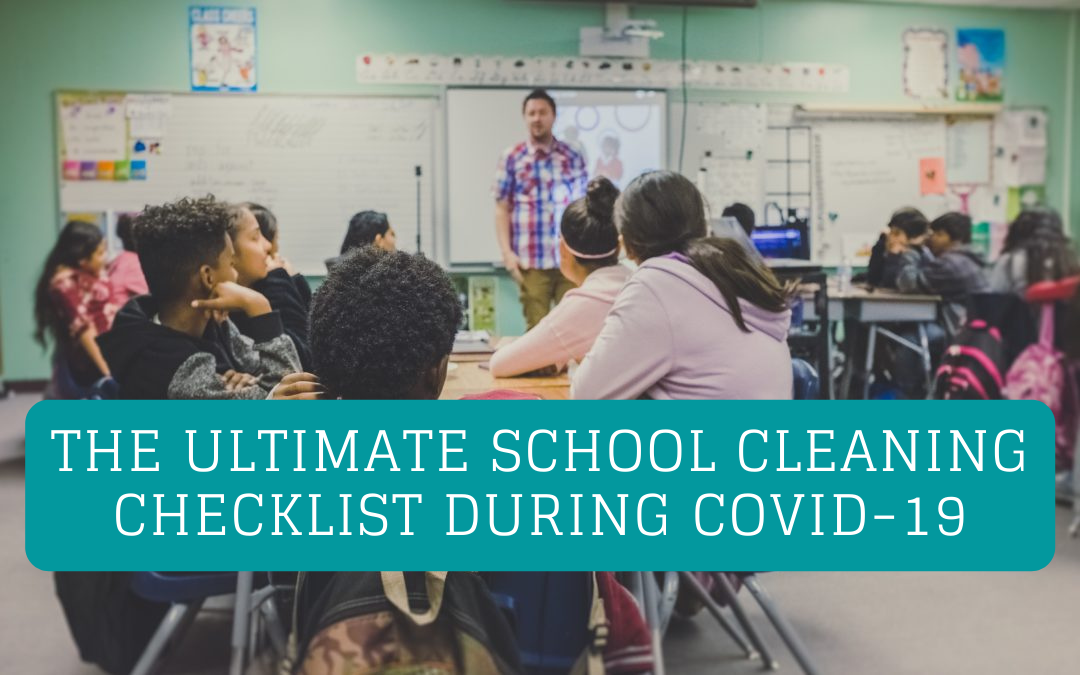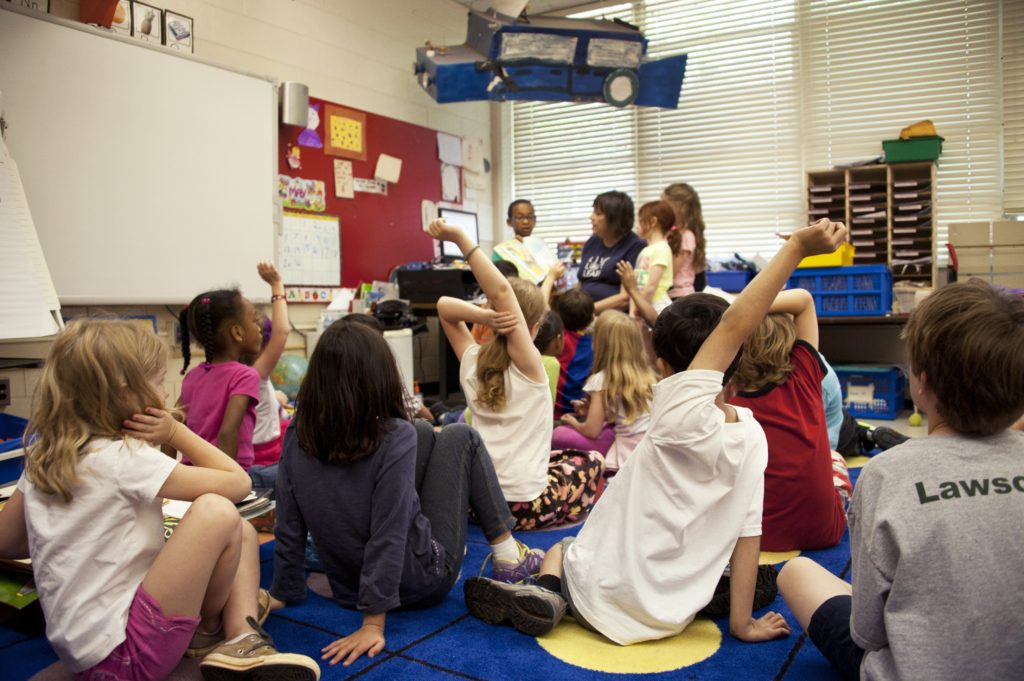Your pre-pandemic school cleaning checklist needs a major overhaul. These are some of the changes you can’t skip.
Up until January 2020, your school cleaning checklist was pretty standard. Sweep and mop the floors, change the trash bags, and give the door handles a few extra wipe downs during cold and flu season. In February 2020, you started taking some additional precautions and made sure your janitorial crew disinfected high-touch surfaces more often.
And then in March, everything changed. On March 12, Ohio announced a three-week school closure. State after state followed, announcing two, three, and four-week closures. Then on March 17, Kansas became the first state to close schools for the remainder of the academic year. With only a small number of exceptions, one state after another followed the lead of Kansas, closing schools for the rest of the year.
As COVID-19 spread, we learned more about it almost every day. But even as our knowledge grew and recommendations changed, one thing held steady: the hyperfocused attention on cleaning. We, as a society, have probably never been so conscious of the spread of germs and how much we can do to prevent that spread with good old-fashioned cleaning.
Only, it’s a little more than just some elbow grease and your favorite household cleaner.
According to the Centers for Disease Control and Prevention (CDC), COVID-19 spreads through respiratory droplets. When an infected person coughs, sneezes, or talks, these droplets can spread directly to another person, or they can land on surfaces where they can live for up to several days. Worse, someone without symptoms can carry and spread the virus. The World Health Organization (WHO) points out that “the COVID-19 virus can survive for up to 72 hours on plastic and stainless steel.”
And because this is a new virus, we don’t have any built-up immunity, so it can spread and impact people quickly.
No doubt, you can imagine how easily any virus could spread in a school filled with hundreds of kids talking, coughing, playing, sneezing, touching things, and just generally being kids. Whether you’re in charge of a small elementary school or a large high school, there’s no getting away from the fact that a school building is an ideal environment for the COVID-19 virus to circulate.
Here’s the good news, though. Regular cleaning and disinfecting can slow the spread of COVID-19, as long as your team follows the right protocols.
Increase the efficiency of your team, reduce your costs, and improve results. With Janitorial Manager, all this and more isn’t just a dream, it’s your new reality. Contact us for a free demo right now and see how it works!
Before you create your school cleaning checklist
Eventually, schools will reopen, and you will need to embark on a new cleaning routine. Before you start on your school cleaning checklist, meet with your janitorial team, and discuss cleaning protocols. The very first thing to go over is the difference between cleaning and disinfecting. The CDC points out that “cleaning does not kill germs, but by removing them, it lowers their numbers and the risk of spreading infection. If a surface may have gotten the virus on it from a person with or suspected to have COVID-19, the surface should be cleaned and disinfected. Disinfecting kills germs on surfaces.”
So right from the start, you should have a two-part cleaning strategy. The other piece to discuss is the actual product your team uses to clean and disinfect. The Environmental Protection Agency (EPA) offers a list of products that are effective against another human coronavirus similar to SARS-CoV-2 (COVID-19) or viruses that are harder to kill than SARS-CoV-2.
This next part is especially important.
The efficacy of a disinfectant is highly dependent on your janitorial team following the label directions. And they can’t just spray a surface then wipe it down immediately. Many of these products require contact times of one to ten minutes to be effective.
For example, Clorox Clean-Up Cleaner + Bleach requires one minute of contact time, while Clorox Disinfecting Spray needs ten minutes of contact time to work correctly, and the contact time on Lysol Brand All-Purpose Cleaner is two minutes. The EPA’s List N: Products with Emerging Viral Pathogens AND Human Coronavirus includes in all approximately 400 products suitable for use against SARS-CoV-2 .
Your updated school cleaning checklist
So now that you have the information you need and a plan to proceed, here is your school cleaning checklist, including many overlooked places. The CDC recommends cleaning and disinfecting these surfaces daily at a minimum. High-touch surfaces will need more frequent cleaning. For example, the CDC recommends cleaning and disinfecting some objects, like keyboards, between each use. And remember, unless otherwise noted, this list assumes both cleaning and disinfecting.
Outdoor areas:
- Playground equipment (routine cleaning only – the CDC currently recommends against disinfecting these surfaces.)
- Swings
- Climbing structures
- Ladders
- Toys
- Tables
- Benches and chairs
- Doorbells, buzzers, and intercom buttons
- Door handles
- Railings
Throughout the school:
- Light switches and switch plates
- HVAC vents
- HVAC filters, if applicable, otherwise replace them regularly, and switch to filters with a higher MERV rating if possible. (Higher MERV ratings equate to more particle filtration.)
In the halls:
- Door handles
- Handrails
- Water fountains
- Carpets
- Elevator buttons
In the classroom and offices:
- Desktops and in-desk storage
- Seats
- Classroom books
- Class equipment (microscopes, globes, pencil sharpeners, etc.)
- Administrative equipment (copier buttons, fax machines, etc.)
- Storage spaces (cubes, coat racks, etc.)
- Floors
- Door, closet, and cupboard handles
- Telephones
- Touchscreens
- Keyboards (These are difficult to clean. Ideally, use a keyboard cover that is easy to remove and disinfect.)
- Waste and recycling bins
- Public Address systems
- Shared binders (late sign in, sign out, etc.)
Cafeteria:
- Tables
- Chairs
- Handrails
- Countertops
- Touchscreens
- Napkin dispensers
- Vending machine buttons
- Microwave handles and buttons
- Refrigerator and freezer door handles
- Waste and recycling bins
Restrooms:
- Doorknobs and handles
- Faucet handles
- Paper towel dispenser handles
- Hand dryer buttons
- Soap dispenser buttons
- Toilet paper dispensers
- Sanitary napkin dispensers
- Toilet flush handles
- Toilet doors, door handles, and locks
Athletic facilities:
- Locker rooms
- Locker handles
- Benches
- Door handles
- Wrestling mats
- Shared sports equipment (balls, shotputs, etc.)
- Pool equipment (flotation devices)
Auditoriums and Gyms:
- Seats
- Benches
- Scoreboard buttons
- PA equipment
Take a look at this school cleaning checklist with your janitorial team. You may find some parts of it that do not apply to you, or you may want to add items. This should, at the very least, give you a thorough starting point. There are a few quick notes to add here.
If at all possible, allow fresh, outside air into the school. Increased ventilation dilutes the number of pathogens in the air, and more air movement can disrupt the concentration of germs in one place.
There is also a critical caveat from the EPA: “Disinfectants should not typically be applied on items used by children, especially any items that children might put in their mouths. Many disinfectants are toxic when swallowed.”
And be sure to use Janitorial Manager to track your supplies, equipment maintenance, and so much more.
Make sure your cleaning team has the information they need to complete their job accurately and thoroughly. Implementing a janitorial software like Janitorial Manager can effectively transform your cleaning operation!



I’m impressed, I need to say. Really rarely do I encounter a weblog that’s both educative and entertaining, and let me let you know, you have got hit the nail on the head. Your idea is excellent; the problem is one thing that not enough people are talking intelligently about. Im very happy that I stumbled across this in my seek for something referring to this. http://www.piano.m106.com